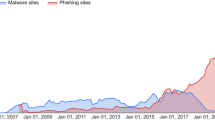Abstract
Phishing is an act of stealing our precious, personal, sensitive data such as credentials that which we use for accessing the resources and services, available across the cyberspace. Seeing these rapidly growing phishing attacks and their adverse effect on the businesses including individual users, it has now become a need for the organizations and individuals worldwide to be able to effectively predict the phishing website and differentiate them from legitimate ones. The aim of this research paper is to efficiently predict the phishing websites so that users may be benefitted from this study and prevent them from getting trapped. In this paper, machine learning techniques are used for prediction. Data mining is used worldwide by almost every face of the society viz. business organizations, govt. organizations, and other kind of data collectors to extract knowledge from the collected data. On the other hand, machine learning is a data mining technique that is used to analyze, classify the data, and efficiently predict the results for the estimation and planning by all of the organizations all around the globe. Classification algorithms, namely logistic regression, decision tree, and random forest classification, are used to predict the fake websites and presented their comparison of their predictions achieved. The results have been presented in numeric format as well as graphically with the help of chart. The data used is taken from UCI machine learning online repository. The seed value is changed and analyzed, and results achieved are least accuracy of 95.93, 97.96, and 98.78% of accuracy as the highest as well. Some future study and applying some good practices may help in designing a better and more accurate solution for the prediction of the phishing website, just by examining the URL and its features.
Access this chapter
Tax calculation will be finalised at checkout
Purchases are for personal use only
Similar content being viewed by others
References
APWG | Phishing Activity Trends Reports (2020). https://apwg.org/trendsreports/. Last Accessed 05 May 2020
Kiruthiga, R., Akila, D.: Phishing websites detection using machine learning. 2, 111–114 (2019). https://doi.org/10.35940/ijrte.B1018.0982S1119
Koray, O., et al.: Machine learning based phishing detection from URLs. Expert Syst. Appl. 117, 345–357 (2019). https://doi.org/10.1016/j.eswa.2018.09.029
Mao, J.: Phishing page detection via learning classifiers from page layout feature (2019)
Leng, K., et al.: A new hybrid ensemble feature selection framework for machine learning-based phishing detection system. Inf. Sci. (Ny) 484, 153–166 (2019). https://doi.org/10.1016/j.ins.2019.01.064
Wang, W. et al.: PDRCNN : precise phishing detection with recurrent convolutional neural networks, (2019)
Surbhi Gupta, A.S.: Dynamic classification mining techniques for predicting phishing. URL. Presented at the (2018)
Kumar, A., Gupta, J.B.B.: A machine learning based approach for phishing detection using hyperlinks information number of unique phishing sites detected. J. Ambient Intell. Humaniz. Comput. (2018). https://doi.org/10.1007/s12652-018-0798-z
Comparison of Classification Algorithms to Detect Phishing Web Pages Using Feature Selection and. 4, (2016). https://doi.org/10.5281/zenodo.61181
Chiew, K.L., et al.: Utilisation of website logo for phishing detection. Comput. Secur. (2015). https://doi.org/10.1016/j.cose.2015.07.006
Abdelhamid, N., Abdel-jaber, H.: Learning comparison based on models content and features. 72–77 (2017)
Ali, W.: Phishing website detection based on supervised machine learning with wrapper features selection. 8(9), 72–78 (2017)
Ho, T.K.: Random decision forests. Proc. Int. Conf. Doc. Anal. Recognition, ICDAR. 1, 278–282 (1995). https://doi.org/10.1109/ICDAR.1995.598994
UCI Machine Learning Repository: Phishing Websites Data Set (2019). https://archive.ics.uci.edu/ml/datasets/Phishing+Websites, Last Accessed 19 Apr 2020
Author information
Authors and Affiliations
Corresponding author
Editor information
Editors and Affiliations
Rights and permissions
Copyright information
© 2021 The Author(s), under exclusive license to Springer Nature Singapore Pte Ltd.
About this paper
Cite this paper
Awasthi, A., Goel, N. (2021). Phishing Website Prediction: A Machine Learning Approach. In: Panigrahi, C.R., Pati, B., Pattanayak, B.K., Amic, S., Li, KC. (eds) Progress in Advanced Computing and Intelligent Engineering. Advances in Intelligent Systems and Computing, vol 1299. Springer, Singapore. https://doi.org/10.1007/978-981-33-4299-6_12
Download citation
DOI: https://doi.org/10.1007/978-981-33-4299-6_12
Published:
Publisher Name: Springer, Singapore
Print ISBN: 978-981-33-4298-9
Online ISBN: 978-981-33-4299-6
eBook Packages: EngineeringEngineering (R0)




